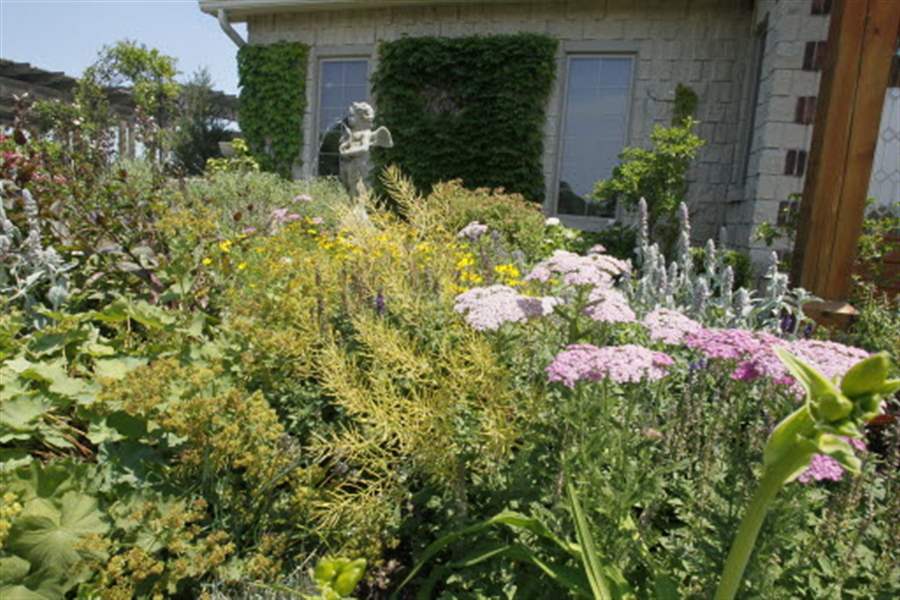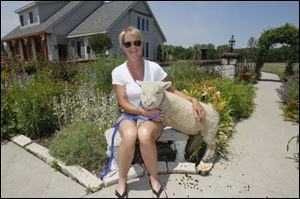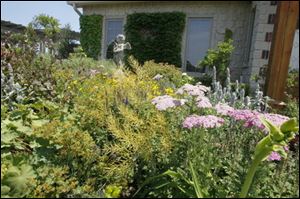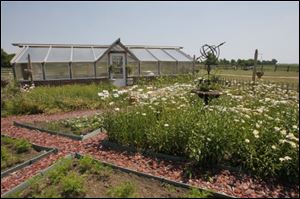
WEED IT & REAP
Elegance meets agriculture on farm in Bowling Green
7/23/2011
The courtyard in front of the house at Fox Fire Farm has four sections, each planted with perennials and incorporating a piece of art.
THE BLADE/JETTA FRASER
Buy This Image

Fae Leffler and Amore, a 4-month-old lamb, in the courtyard garden.
The Blade seeks gardeners for Weed It & Reap who are as varied as what they grow and who dig in gardens large, small, or with unusual content. In a sentence, tell us what is unique about you or your garden. Contact Tahree Lane at tlane@theblade.com or 419-724-6075.
Name: Fae Leffler, homemaker, living at Fox Fire Farm in rural Bowling Green.
Garden specs: Our 65 acres are divided by Tontogany Creek. We grow three crops of hay a year on 25 to 30 acres for the horses.
The walkway to the front of the house from the parking area is through a courtyard-style garden surrounded by a stone and brick wall. It has four 20- by-20-foot quadrants, each planted with perennials and incorporating a piece of art. Outside the wall, a line of short boxwood hedges are trimmed into a repeating pattern of Xs and Os, along with eight standard roses in pots.
The living area (pool, three connecting pergolas, fireplace) are home to a collection of succulents, cacti, ferns, and decorative palm trees. We get a lot of wind out here and I’ve learned that hanging baskets dry out fast.
Behind the house is a Cat Garden (6 by 10 feet) to honor our beloved felines who provide endless comfort and entertainment. It features a few cat sculptures and a cat fountain! The five kitties love to play and hide in the foliage of this partially shaded space.
The kitchen garden (40 by 80 feet) has a layout that combines a medieval sense of order with repetition. Inside a white picket fence, it speaks to a love of detail. Each section has a theme: herbs, veggies (lots of carrots for the ponies), and under netting are berry bushes and fruit trees (apple, peach, pear, and cherry). The backdrop is the ohso- useful greenhouse (20 by 50 feet), for wintering over many large pots and exotic plants.
When did you start gardening? In earnest, around 2000, before the house was done. I’d cut out pictures I liked and made a scrapbook of things I wanted to incorporate, and I mapped it out. In front of the stable I developed the rose garden; we have clay out here so I had to bring in about 15 tons of good, composted soil. We dug out the clay and used it elsewhere; land-movers sculpted out a two-acre pond and built up the land in other places. Also before we moved in, we started the courtyard area in English-garden style.

The courtyard in front of the house at Fox Fire Farm has four sections, each planted with perennials and incorporating a piece of art.
What do you grow? I started with roses of course! The rose garden is in front of the horse stables and features a combo of old-rose shrubs (those that existed before 1867) in delicate pink and white. Lavender plants were added to accentuate the border and create wonderful fragrance, and then a few clematis (the purples bloom in late spring, the whites in fall) were added simply because I love them: they’re like a surprise; one day they’re not there and the next day they’re all open. They can take an area that might look boring and add new interest to a wall or door that needs softening, plus they’re easy to grow.
Along the equestrian training facility are hostas and hydrangeas of different colors. I’d like to grow ivy up the sides, shaped like Xs and Os.
Favorite plant: It’s like picking a favorite horse, impossible! They’re all glorious. I’d have to say the Peace Rose standards because they’re so beautiful and fragrant and a real show-stopper. You have to stop and smell these roses.
Give us a tip: Read Ohio gardening literature and arm yourself with facts about what works in your soil and climate. Know what you want to create and put in good structure and then soften around that: you want color, shape, and some movement to create a dramatic, calming utopia. Make it your own and it will come back to you every spring like the greatest gift. Also, a lot of people tell me they cannot grow lavender. It just needs good drainage and consistent moisture, but no fertilizer the first year.
Hours spent gardening: More than 40 hours a week in the spring; this time of year, about 12 hours.

The kitchen garden and greenhouse.
Challenges: I don’t find many negatives, but my husband will tell you I don’t cook much in the spring. It is just good hard work and I go to bed tired but with a huge sense of satisfaction and pride, and I wake up each morning with a great sense of the possibilities. I walk through the gardens with my dog and cats, listening to the horses nicker and our new, miniature Babydoll Southdown lambs call to me. Everyone is hungry and I am anxious to tend to all the creatures, plant and animal.
I am proud of my boxwood potagers. They started out as little twigs that I got for a buck apiece and I needed a hundred of them. My husband thought I was nuts. They have really turned into a work of art.
What I’ve learned gardening is not to be a afraid to challenge myself artistically. I love The English Garden magazine. I always want to recreate beautiful things I see on their pages, and I’ve learned best by just jumping in and digging. It’s a real sense of freedom.